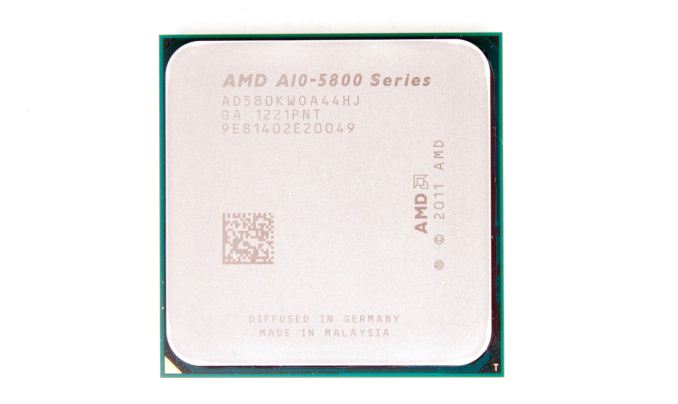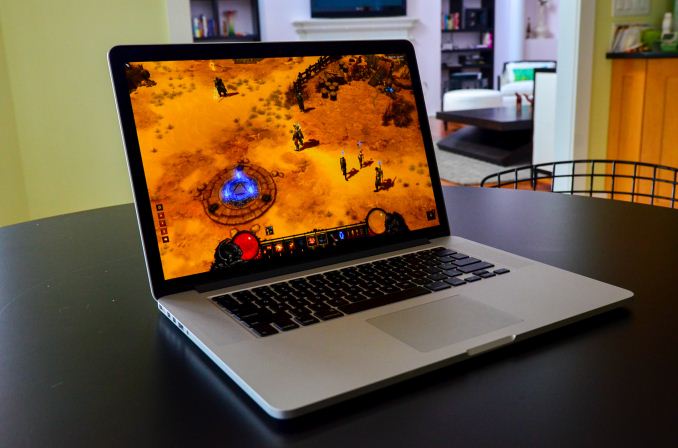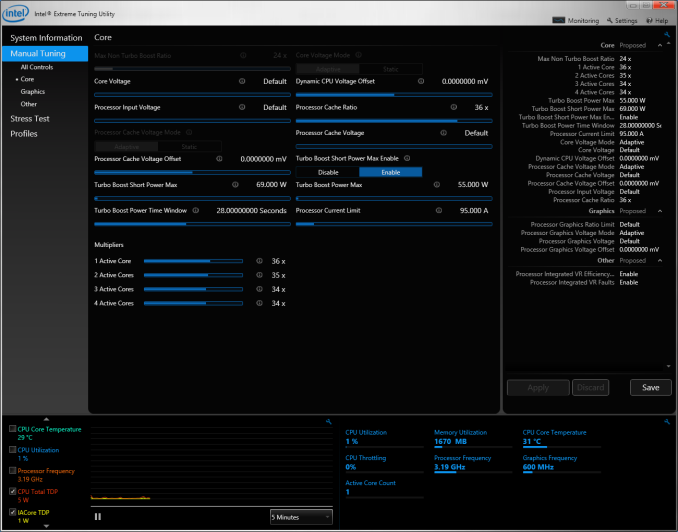Intel Iris Pro 5200 Graphics Review: Core i7-4950HQ Tested
by Anand Lal Shimpi on June 1, 2013 10:01 AM ESTThe Comparison Points
Intel sort of dropped this CRB off without anything to compare it to, so I scrambled over the past week looking for things to put Iris Pro’s performance in perspective. The obvious candidate was Apple’s 15-inch MacBook Pro with Retina Display. I expect its successor will use Iris Pro 5200, making this a perfect comparison point. The 15-inch rMBP is equipped with a GeForce GT 650M with a 900MHz core clock and a 5GHz memory datarate.
I also dusted off a GeForce GT 640 desktop card to shed a little more light on the 650M comparison. The 640 has a slightly higher core clock (925MHz) but it only has 1.7GHz DDR3, working out to be 27GB/s of memory bandwidth compared to 83GB/s for the 650M. Seeing how Iris Pro compares to the GT 640 and 650M will tell us just how good of a job Crystalwell is doing.
Next up is the desktop Core i7-4770K with HD 4600 graphics. This is a Haswell GT2 implementation, but at a much higher TDP than the 47W mobile part we’re comparing it to (84W). In a notebook you can expect a much bigger gap in performance between the HD 4600 and Iris Pro than what we’re showing here. Similarly I also included a 77W HD 4000 for a comparison to Ivy Bridge graphics.
On the AMD front I have the 35W A10-4600M (codename Trinity), featuring AMD’s 7660G processor graphics. I also included the 100W A10-5800 as a reference point since we were largely pleased with the GPU performance of Trinity on the desktop.
I listed TDPs with all of the parts I’m comparing here. In the case of the GT 640 I’m adding the TDP of the CPU (84W) and the GPU (65W). TDP is half of the story with Iris Pro, because the CPU, GPU and eDRAM all fit into the same 47W power envelope. With a discrete GPU, like the 650M, you end up with an extra 45W on top of the CPU’s TDP. In reality the host CPU won’t be running at anywhere near its 45W max in that case, so the power savings are likely not as great as you’d expect but they’ll still be present.
At the request of at least one very eager OEM, Intel is offering a higher-TDP configuration of the i7-4950HQ. Using Intel’s Extreme Tuning Utility (XTU) I was able to simulate this cTDP up configuration by increasing the sustained power limit to 55W, and moving the short term turbo power limit up to 69W. OEMs moving from a 2-chip CPU + GPU solution down to a single Iris Pro are encouraged to do the same as their existing thermal solutions should be more than adequate to cool a 55W part. I strongly suspect this is the configuration we’ll see in the next-generation 15-inch MacBook Pro with Retina Display.
To remove as many bottlenecks as possible I configured all integrated GPU options (other than Iris Pro 5200) with the fastest supported memory. That worked out to being DDR3-2133 on desktop Trinity and desktop IVB, and DDR3-2400 on desktop Haswell (HD 4600). The mobile platforms, including Iris Pro 5200, all used DDR3-1600.
On the software side I used NVIDIA's GeForce R320 v320.18, AMD's Catalyst 13.6 beta and Intel's 9.18.10.3177 drivers with Crystalwell support.













177 Comments
View All Comments
tipoo - Saturday, June 1, 2013 - link
It still seems to me that this misses where it would benefit most: 13 inch laptops, which currently mostly use dual core processors. GT3e would make something like the Retina MBP 13" much more appealing for instance, but it's paired with processors such that the wattage would be too high.tipoo - Saturday, June 1, 2013 - link
Oh and I wanted to ask, if the integrated graphics are disabled can the CPU still tap into the eDRAM?Ryan Smith - Saturday, June 1, 2013 - link
Yes, it's a dedicated cache for both the CPU and the GPU. However it's very unlikely you're going to run into any scenario that uses a Crystalwell-equipped part in such a manner. It's not being sold in socket form, so it will go to OEMs, who in turn would only use it if they didn't include a dGPU.jeffkibuule - Saturday, June 1, 2013 - link
So pretty much, unless you've got some huge beefy GPU that would absolutely suck up power compared to just using Iris Pro graphics, no one would opt for that SKU?shiznit - Saturday, June 1, 2013 - link
Right on. A dual core model for the 13" rMPB would have me selling my 2012 immediately. Now I need to decide if I can live with the 15" or even bother.moep - Saturday, June 1, 2013 - link
If i interpreted the results of this article correctly, I suspect that the 15" MBP is probably going to get a new and even thinner form factor with this refresh. (one chip less, fewer VRM related parts, lower combined TDP)A 15" rMBP approaching the weight of a 15" Macbook Air would be very interesting, although a part of me hoped that Apple would wait until Broadwell to ditch the dGPU in the 15".
Such a step back in GPU performance with the Retina display is surely not going to be very pleasant in 3D applications.
Galatian - Saturday, June 1, 2013 - link
I actually hope/suspect, that Apple will go the other road: use a discrete graphic solution on the 15" rMBP until Broadwell comes out, but have a cTDPdown version of the 4850HQ on the 13" rMBP. Maybe they can even get the normal TDP version in there; after all it has the same (good) cooling the 15" rMBP has and I have never heard the fans on mine. I think Apple really designed it with Haswell in mind, so let's see what they'll bring on during the next few weeks.tipoo - Saturday, June 1, 2013 - link
That's certainly the best case, I really hope they go down that road. The rMBP as a quad with Iris Pro would really make it worth the Pro name.vFunct - Sunday, June 2, 2013 - link
They'll probably stick with the built in GPU for the 13" model and a discrete GPU for the 15" model, which is what they do right now.Apple's top-end MacBook Pro has always had the highest end discrete GPU available.
Spunjji - Tuesday, June 4, 2013 - link
I'm guessing you mean "for a given power usage", as there are definitely faster GPUs out there than the 650M.